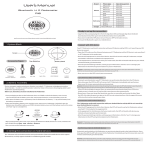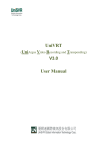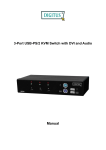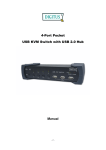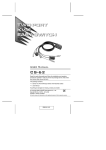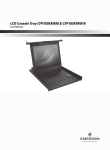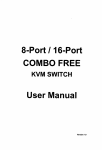Download User`s Manual
Transcript
3-Port COMBO FREE DVI KVM SWITCH ( with Audio ) User’s Manual Revision 2.0 1. Introduction Thank you for your purchase of Combo Free DVI KVM Switch! You now have a high quality, durable system that will enable you to control 3 Host computers and/or servers by using PS/2 and/or USB Connectors from one console (PS/2 & USB Mouse, PS/2 & USB Keyboard, and Monitor). 1.1 Features 1. Console your Keyboard/Mouse via either way of PS/2 and/or USB arbitrarily. 2. Controls 3 DVI computers from a single console (Keyboard/Mouse) over USB and/or PS/2 connections. 3. Speaker enabled. 4. Microphone enabled. 5. Supports Windows, Linux, Mac OS9/OSX, Sun Microsystems. 6. Emulates a keyboard on each PC to allow your computers to boot normally without a keyboard error. 7. 8. 9. 10. 11. 12. 13. 14. Supports hot-swap. All devices connected to the KVM can be added or removed at any time, without shutting the unit down. Supports 2 types of switching: (1) Hardware Push Button, (2) Hot-Keys on PS/2 and/or USB of keyboard arbitrarily. Supports Auto-Scan function to switch video automatically among computers in preset intervals sequentially. Supports LED display for PC status monitoring. Supports DVI UXGA resolutions up to 1920 x 1200 @ 60HZ. Supports Beeper during switching enabled. Self powered through USB connection. Fully compliant with the USB 1.1/ 2.0 specification. 1.2 LED Indicators: Selected : RED LED indicates that the KVM Switch is selected to the corresponding PC. On-Line : GREEN LED indicates that the KVM Switch is ready to the corresponding PC. 1.3 Package Contents The product you purchased should contain the following equipment and accessories: 1. 3-Port Combo Free DVI KVM Switch . 2. User Manual. 3. Three sets of ( DVI + USB/Audio ) cables. 2 2. Specifications 2.1 General Specification Number Of Computers Controlled Selection Method LEDs PC Connectors Console Ports Video USB Speaker Microphone Keyboard Mouse Video Keyboard Mouse Speaker Microphone Auto-Scan Interval DDC, DDC2 DVI UXGA monitor Hot Swappable Operating systems supported 3 Push Button and Hot-Key (PS/2 and/or USB Keyboard) Red for PC Selection Green for PC On-Line ready 3 x DVI UXGA female 3 x USB - B type female 3 x audio female jacket 3 x audio female jacket 1 x 6 pin mini-DIN female 1 x 6 pin mini-DIN female 1 x DVI UXGA female 1 x USB - A type female 1 x USB - A type female 1 x audio female jacket 1 x audio female jacket From 5 to 250 Seconds Up to resolution: 1920 x 1200@60Hz Yes Windows 98SE/ME/2000/XP/Vista/Win7/2003 Server, Linux Mac OS9/OSX and Sun Microsystems Device driver Power Cable Length Dimensions (L X W X H) No Need Unit Weight Housing material Operating Temperature 650 g Metal Humidity 0%~80%RH By PS/2 and/or USB or External Power Adaptor (Optional) 6 feet (1.80 Meter) 21.5 x 8.8 x 4.5 cm (5.5 X 3 X 1.7 inches) 32~ 122°F (0~ 50°C ) 3 3. System Requirements Console DVI monitor capable of the highest resolution. PS/2 and/or USB Keyboard/Mouse Computer or Server The following equipment must be equipped with each computer or server. - Type A USB port. - DVI connector. Cables The Combo Free DVI KVM Switch is using separate (DVI + USB/Audio) cables. To purchase the specific cable sets, please contact your dealer. 4. Single installation 4.1 Precaution: 1. With under running OS Windows 98 , we sugget that the PC must be plugged to PS/2 ports, because of Windows 98 is not support installation at first time as through USB HID installation driver. 2. There are some of older PCs can support USB ports during booting, but you need to open BIOS USB setting at first. 3. The KVM switch does not support the USB keyboard which has built-in USB HUB. 4 5. Operations The 3-Port Combo Free DVI KVM Switch has the ability to switch the keyboard, video, mouse simultaneously Note: When using the two-step Hot Key sequences, the keys must be pressed within 5 seconds; otherwise the Hot Key action will be terminated. 5.1 Push Button on front panel 5.2 Hotkey Selection ( USB and/or PS/2 keyboard ) Note: If your keyboard is without < Scroll Lock > button, please press < Caps Lock > or <Num Lock > instead of Scroll Lock ( ref. 5.2.0 ). 5.2.0 Instead hotkey Selection Hot Key: [Ctrl] → [Ctrl] → [Caps Lock] → [Enter] : The hotkey changed to [Caps Lock] [Ctrl] → [Ctrl] → [Num Lock] → [Enter] : The hotkey changed to [Num Lock] [Ctrl] → [Ctrl] → [Scroll Lock]→ [Enter] : The hotkey reversed to [Scroll Lock] Note : The default hotkey setting is <Scroll Lock> button as if you chang the hotkey default setting, the new setting will effect on the KVM switch until power off or reset. 5.2.1 PCs Selection Hot Key: [Scroll] → [Scroll] → [ 1 ] → [Enter] [Scroll] → [Scroll] → [ 2 ] → [Enter] [Scroll] → [Scroll] → [ 3 ] → [Enter] or or 5 You can synchronize the PC selection, by using the following two-step Hot Key sequence. To send commands to the Combo Free DVI KVM Switch, press the [Scroll] key twice (Step 1), then press key [1] or [2] or [3] and [Enter] (step 2) to assign the PC to a particular PC. ( If you press key [1] or [2] or [3] on the number pad, the keyboard, mouse & video will also be switched synchronously ) 5.2.2 Auto-Scan Function Hot Key: [Scroll] → [Scroll] → [S] → [Enter] to BEGIN. [Scroll] → [Scroll] → [S], → [Enter] to STOP. You can activate the Auto-Scan function by using the following two-step Hot Key sequence. To send commands to the Combo Free DVI KVM Switch, press the [Scroll] key twice (Step 1), then press [S] and then press [Enter] (Step 2). When you press the Auto-Scan hot key sequence, the Combo Free DVI KVM Switch alternates between the three PCs and displays them on the monitor. Each PC is display one of time interval from 5 ~ 250 seconds (The interval is adjustable) before switching to the next. When you press the Auto-Scan Hot Key sequence again, the Auto-Scan will stop and the monitor screen will jump back to the original PC. Adjustable scan time interval setting ( 5 ~ 250 sec. ) Hot-key: Pressing the <Scroll >, <Scroll > then <S> and <10 ~250 > <Enter> 6 5.2.3 Beeper Enable Hot Key: [Scroll] → [Scroll] → [B] → [Enter] to Disable [Scroll] → [Scroll] → [B] → [Enter] to Enable . The Speaker/Beeper’s default setting is “Enable”. While the switching connections are activated and Speaker/Beeper is in “Enable” status, the beeper has a short beeping sound. 5.3 Audio ( Speaker + Microphone ) Selection 5.3.1 ( PC+Audio ) Combination Selection Hot Key: [Scroll] → [Scroll] → [ F1 ]→[Enter] [Scroll] → [Scroll] → [ F2 ]→[Enter] [Scroll] → [Scroll] → [ F3 ]→[Enter] or or 7 5.3.2 Single Audio ( Speaker + Microphone ) Selection Hot Key: [Scroll] → [Scroll] → [A] →[Enter] to enable or disable the audio auto switch mode [Scroll] → [Scroll] → [A] → [1]→ [Enter] to select PC1 Speaker and Microphone [Scroll] → [Scroll] → [A] → [2]→ [Enter] to select PC2 Speaker and Microphone [Scroll] → [Scroll] → [A] → [3]→ [Enter] to select PC3 Speaker and Microphone Note 1: Audio auto switch mode, the default setting of KVM switch is enabled, means when you used the push button, the PCs and Audio will be switched at the same time. In case of the Audio auto switch mode is disabled, then the push button only switch PCs. Note 2: One long sound – Audio auto switch disabled Two short sound – Audio auto switch enabled A 8 Hot Key definition table Step 1 Step 2 Action [Scroll] + [Scroll] [1] + [ Enter ] [2] + [ Enter ] [3] + [ Enter ] Switch the active connection to PC 1 Switch the active connection to PC 2 Switch the active connection to PC 3 [A] + [ Enter ] [F1] + [ Enter ] [F2]+ [ Enter ] [F3] + [ Enter ] Disable or enable the Audio auto switch mode Combined switching (PC+Audio) to PC 1 Combined switching (PC+Audio) to PC 2 Combined switching (PC+Audio) to PC 3 [Scroll] + [Scroll] [Scroll] + [Scroll] [Scroll] + [Scroll] [Scroll] + [Scroll] [Scroll] + [Scroll] [Scroll] + [Scroll] [Scroll] + [Scroll] [A] + [1] + [ Enter ] Single switching the active audio to PC 1 Single switching the active audio to PC 2 Single switching the active audio to PC 3 [Scroll] + [Scroll] [A] + [2] + [ Enter ] [Scroll] + [Scroll] [A] + [3] + [ Enter ] [Scroll] + [Scroll] [Scroll] + [Scroll] [Scroll] + [Scroll] [B] + [ Enter ] [S] + [Enter] [S] + [5 -250 ] + [ Enter ] Disable or enable beeper Activate the Auto-Scan mode, default 5 sec. Select the Auto-Scan interval from 5 to 250 Sec. 9 Sun Microsystems Function Key Emulation: There are 16 special functions on the Sun Microsystems keyboard, the Combo Free DVI KVM Switch can emulate these function keys via the PS/2 and/or USB keyboard. Here is the mapping table for these functions operation. To active these emulation on the PS/2 and/or USB keyboard, you have to press the LEFT Window KEY first (this key usually is located between the left [Ctrl] and left [Alt]), then choice the second relative key. Sun Micro System Function Key Stop PS/2 Keyboard Props L_Win & L_Ctrl Compose L_Win & L_Shift Front L_Win & F1 Open L_Win & F2 Find L_Win & F3 Again L_Win & F4 Undo L_Win & F5 Copy L_Win & F6 Paste L_Win & F7 Cut L_Win & F8 Help L_Win & F11 Power L_Win & F12 Mute L_Win & 1 Volume Down L_Win & 2 Volume UP L_Win & 3 L_Win & L_Alt 10 Disclaimer Information in this document is subject to change without notice. The manufacturer does not make any representations or warranties (implied or otherwise) regarding the accuracy and completeness of this document and shall in no event be liable for any loss of profit or any other commercial damage, including but not limited to special, incidental, consequential, or other damages. No part of this document may be reproduced or transmitted in any form by any means, electronic or mechanical, including photocopying, recording or information recording and retrieval systems without the express written permission of the manufacturer. All brand names and product names used in this document are trademarks, or registered trademarks of their respective holders. FCC Statement This device generates and uses radio frequency and may cause interference to radio and television reception if not installed and used properly. This has been tested and found to comply with the limits of a Class B computing device in accordance with the specifications in Part 15 of the FCC Rules. These specifications are designed to provide reasonable protection against such interference in a residential installation. However, there is no guarantee that interference will not occur in a particular installation. If this device does cause harmful interference to radio or television reception, which can be determined by plugging the device in and out, the user can try to correct the interference by one or more of the following measures: Reorient or relocate the receiving antenna. Increase the separation between the device and receiver. Connect the computer into an outlet on a circuit different from that to which the receiver is connected. Consult the dealer or an experienced radio/TV technician for help. 11













